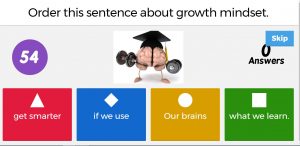Didn’t make it to SXSWEdu? Here are some highlights from what I shared daily from the Kahoot Activity Lounge. I shared ideas on using Kahoot to promote authentic language production by newcomers (and all kids).
We caught the first few minutes of my presentation on video: 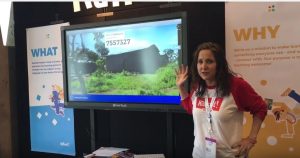
So are you familiar with Kahoot? It is super easy to make an online quiz and students don’t need to create accounts to play. You can even search the millions that are already made & play one of those. Students LOVE Kahoot. If you try it, you’ll find that students actually request that you review content this way.
So now… how do I use Kahoot to promote language learning? Well, let’s remember that as an educator, my goal with language acquisition is to provide sheltered learning opportunities. My two big objectives for this are to
1) Make Content Comprehensible
2) Develop Academic Language
Making Content Comprehensible
Visuals and gestures are high on this list of things that help a language learner comprehend your message. For example, if I am telling my class that the earth is the third planet from the sun, I may get some blank stares from my students who are new arrivals. It likely sounds like “The blah is the blah blah blah the blah.” But if I point to this image of the earth and count over with my fingers 1, 2, 3 and then point to the sun while I say that… there is usually instant comprehension from anyone who is watching.

(Image from www.elisbergindustries.com)
Know what else? Many of my native speakers benefit from this visual as well! Most of my students are not auditory learners. Take a look at that picture and tell me if that wouldn’t be helpful to any child who is learning that concept? So here is what it looks like in the middle of a Kahoot game.
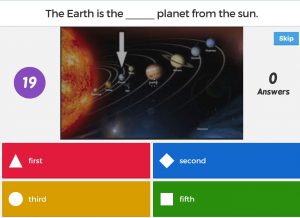
But look at this quiz. WHY would I wait to use this after I have taught a concept? Why not use this highly engaging activity to TEACH this concept?
There are some amazing Kahooters out there creating “Blind Kahoots” that offer an example of how to build a lesson with Kahoot. Stephanie Castle, (@castlestephanie) High School IB Bio teacher in New York, pioneered this concept and her Mitosis Blind Kahoot is a great example. This is so successful with students that Kahoot now offers a template for creating your own Blind Kahoot. Everything you want to know about this is here: The Art of Blind Kahooting
We know that our language learners are going to benefit from learning concepts this way. If you allow students to take a stab at the answer, and then pull the image back up before you go on to the next question, your Kahoot becomes a super engaging, interactive presentation with visuals and opportunities for more sheltered strategies by the teacher. It is pretty great to have the undivided attention of your class while you bring everyone back to the image to explain why the answer is what it is. Not only is this powerful for all your visual learners, it is a great opportunity to work in test taking strategies. How many of our students are missing standardized test questions because they are not attending to the image? Be thoughtful about your images and point out the power of attending to them. Teaching the concepts this way has been working extremely well with my newcomer class.
Developing Academic Language
Making your content comprehensible and engaging for the class is a huge win. But for us, we are getting even more mileage out of our Kahoot lessons because we are intentional about building the students’ academic language. We know that we internalize concepts more if we verbalize them. I want my students feeling comfortable with the language as soon as possible. I want all students speaking academically because it will cement learning and open doors for them if they get into the habit. Therefore, I am a big proponent of newcomers reading in unison for practice with pronunciation. Most language learners are very fixated on how they sound when speaking in their second language. According to Stephen Krashen, we will get a lot further with our students if we can lower their anxiety about participating in class. (http://www.sk.com.br/sk-krash.html) If they feel comfortable pronouncing words like “homologous pair of chromosomes,” we have a better shot at getting them to use that language when we ask them to speak authentically about our content. This is why we always read the question stem and correct answer all together before we move on to the next question.
See these examples of what we would practice learning AND saying through a Kahoot on explorers:
All of my students are benefitting from the learning of content this way. My newcomers are practicing complete academic sentences and also comprehending the content because I am teaching with visuals & gestures. In that example, I made both “ship” and “vessel” correct answers so we could point out that new vocabulary for all students.
Marie Heath (@ELLatPISD) of Plano ISD recently gave me a great idea for a variation on this. She suggests turning all of the questions into True/False statements. Your answers could be changed to “I agree” and “I disagree.” Kahoot allows you to turn off the points so that it is not a competition but rather a springboard for discussion. Marie’s idea is to use this “Agree/Disagree” Kahoot as an anticipatory set. Jennifer Gonzalez (@cultofPedagogy) has a great blog post here about the power of the anticipatory set. I love this idea because you are using the engagement of Kahoot to have students critically thinking, they are practicing the language and using it in authentic conversations.

Practicing the new language will lead to more comfort USING the new language. Here is a video of a day that I had EIGHT newcomers arrive in class and I wanted a way to review our social contract. Kahoot to the rescue. Newcomers practicing their new language on Day one: https://youtu.be/rt-P3t3BbHw
JUMBLE
Another feature that I know I will share is the new way to use Kahoot called Jumble. You are basically re-ording words or phrases so that they are in the correct sequence. This is an example of the game screen for a jumble I am using:
The players have a screen that looks like this on their device:
They are to drag the colors/shapes into the correct order. There are obvious benefits here for second language acquisition. You have visuals and opportunities for oral practice as we stated earlier. You also have the advantage of creating sentences that are aligned with your grammar goals. And don’t forget that you can throw in sentences that are inspirational or meaningful to their learning.
This is a practice jumble I made for staff development: https://play.kahoot.it/#/k/6241fb11-6017-47e8-8c85-1195444210c6
Creating
What about your newcomer #ELLs creating Kahoots?? Yes! They can. Check out this blogpost on how:
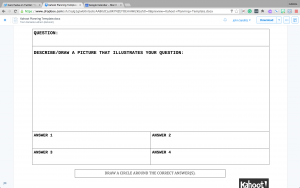
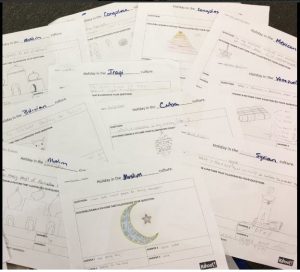
Holiday Traditions Selfie Kahoot = Authentic Writing & Global Learning
I’m only scratching the surface of what we do with Kahoot to inspire students to use language authentically. Below are a few other posts I have done about Kahoot. Check those out our just start using the free platform. I’m sure you will be inspired to think of even more innovative ways to facilitate academic conversations while you have the undivided attention of every student!
Happy Kahooting!
Carol
Kahoot with Brand New ELs + Skype with Krew

